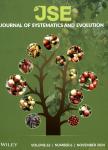版权所有:内蒙古大学图书馆 技术提供:维普资讯• 智图
内蒙古自治区呼和浩特市赛罕区大学西街235号 邮编: 010021

作者机构:School of Biological SciencesWashington State UniversityPullmanWashingtonDC 99164-4236USA Departamento de Biología(Botánica)Facultad de Ciencias BiológicasUniversidad Autónoma de Madridc/Darwin 2 Madrid 28049Spain Centro de Investigación en Biodiversidad y Cambio Global(CIBC-UAM)Universidad Autónoma de MadridMadrid 28049Spain The Morton Arboretum4100 Illinois Route 53 LisleIL 60532USA Department of Molecular Biology and Biochemical EngineeringUniversidad Pablo de OlavideSevilla 41013Spain Department of Integrative BiologyUniversity of Colorado DenverDenverCO 80217-3364USA Jungwon UniversityGoesanChungbukSouth Korea Departamento de Biología Vegetal y Ecologíaárea de BotánicaFacultad de BiologíaUniversidad de SevillaSevilla 41012Spain Department of Biological SciencesUniversity of ManitobaWinnipegManitoba R3T 2N2Canada Allan HerbariumManaaki-Whenua Landcare ResearchPO Box 69040 LincolnCanterbury 7640New Zealand Department of Systematic BotanyMartin Luther University Halle-Wittenberg Geobotany and Botanical GardenHalle(Saale)D-06108Germany Johannes Gutenberg University of MainzMainz D-55122Germany Plant Systematics and Evolution LaboratoryDepartment of Plant BiotechnologyAtta-Ur-Rahman School of Applied Biosciences(ASAB)National University of Sciences and Technology(NUST)IslamabadPakistan College of Life and Environment SciencesHangzhou Normal UniversityHangzhou 311121China Department of BiologySungshin Women's UniversitySeoul 01133South Korea Royal Botanic GardensKewRichmondSurrey TW9 3AEUnited Kingdom Systematic and Evolutionary Botany LabDepartment of BiologyGhent UniversityK.L.Ledeganckstraat 35 Gent 9000Belgium Département de Sciences BiologiquesInstitut de Recherche en Biologie Végétale de I'Université de Montréal4101 Sherbrooke East MontréalQuebec H1X 2B2Canada College of Life SciencesZhejiang UniversityHangzhou 310058China Department of Biosphere-Geosphere ScienceFaculty of Biosphere-Geosphere ScienceOkayama University of ScienceOkayama 700-0005Japan New York Botanical GardenBronxNY 10458USA University of Michigan HerbariumAnn ArborMI 48108USA Department of Ecosystem Science & ManagementTexas A & M UniversityCollege StationTX 77843USA Department of BiologyUniversity of OttawaGendron HallRoom 16030 Marie Curie OttawaOntario K1N 6N5Canada Departamento de Biología y GeologíaUniversidad de AlmeríaCtra.Sacramento s/n Almería 04120Spain Plant Science DepartmentMcGill UniversitySte-Anne-de-BellevueQuebec H9X 3V9Canada National Herbarium New South WalesSydneyNew South WalesAustralia Institute of BotanyChinese Academy of SciencesBeijing 100093China
出 版 物:《植物分类学报》 (Journal of Systematics and Evolution)
年 卷 期:2021年第59卷第4期
页 面:726-762页
核心收录:
学科分类:0710[理学-生物学] 071001[理学-植物学] 07[理学]
基 金:support by the National Science Foundation the Spanish Ministry of Economy and Competitiveness postdoctoral fellowships supporting SM‐B (Universidad Pablo de Olavide) PJ‐M (National Science Foundation, Award) the Smithsonian Postdoctoral Fellowship program Regional Government of Madrid, Spain, Macondo
主 题:Carex clades classification sections subgenera
摘 要:Phylogenetic studies of Carex L.(Cyperaceae)have consistently demonstrated that most subgenera and sections are para-or ***,taxonomists continue to use subgenera and sections in Carex ***?The Global Carex Group(GCG)here takes the position that the historical and continued use of subgenera and sections serves to(ⅰ)organize our understanding of lineages in Carex,(ⅱ)create an identification mechanism to break the~2000 species of Carex into manageable groups and stimulate its study,and(ⅲ)provide a framework to recognize morphologically diagnosable lineages within ***,the current understanding of phylogenetic relationships in Carex is not yet sufficient for a global reclassification of the genus within a Linnean infrageneric(sectional)*** than leaving Carex classification in its current state,which is misleading and confusing,we here take the intermediate steps of implementing the recently revised subgeneric classification and using a combination of informally named clades and formally named sections to reflect the current state of our *** hybrid classification framework is presented in an order corresponding to a linear arrangement of the clades on a ladderized phylogeny,largely based on the recent phylogenies published by the *** organizes Carex into six subgenera,which are,in turn,subdivided into 62 formally named Linnean sections plus 49 informal *** framework will serve as a roadmap for research on Carex phylogeny,enabling further development of a complete reclassification by presenting relevant morphological and geographical information on clades where possible and standardizing the use of formal sectional names.